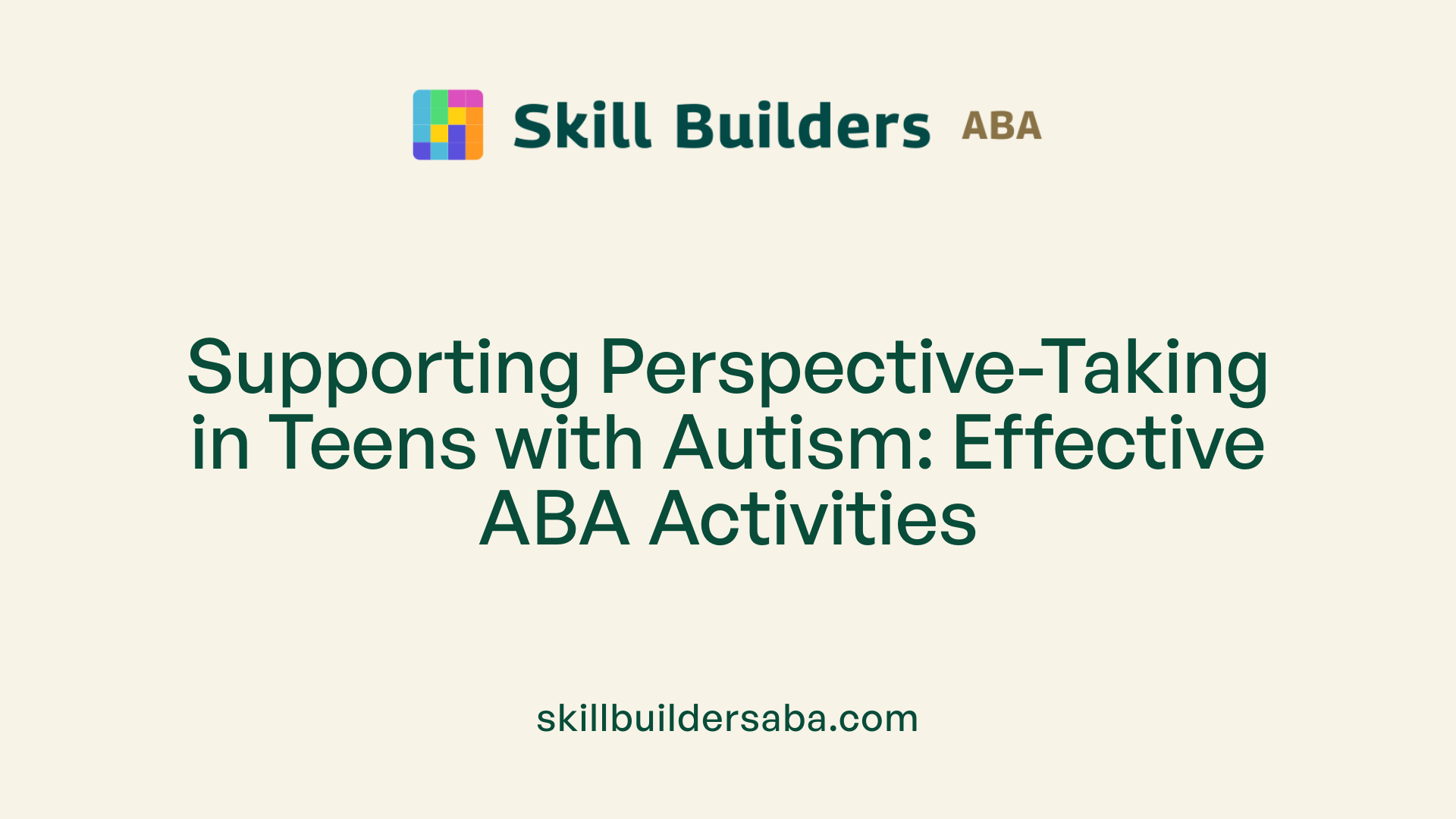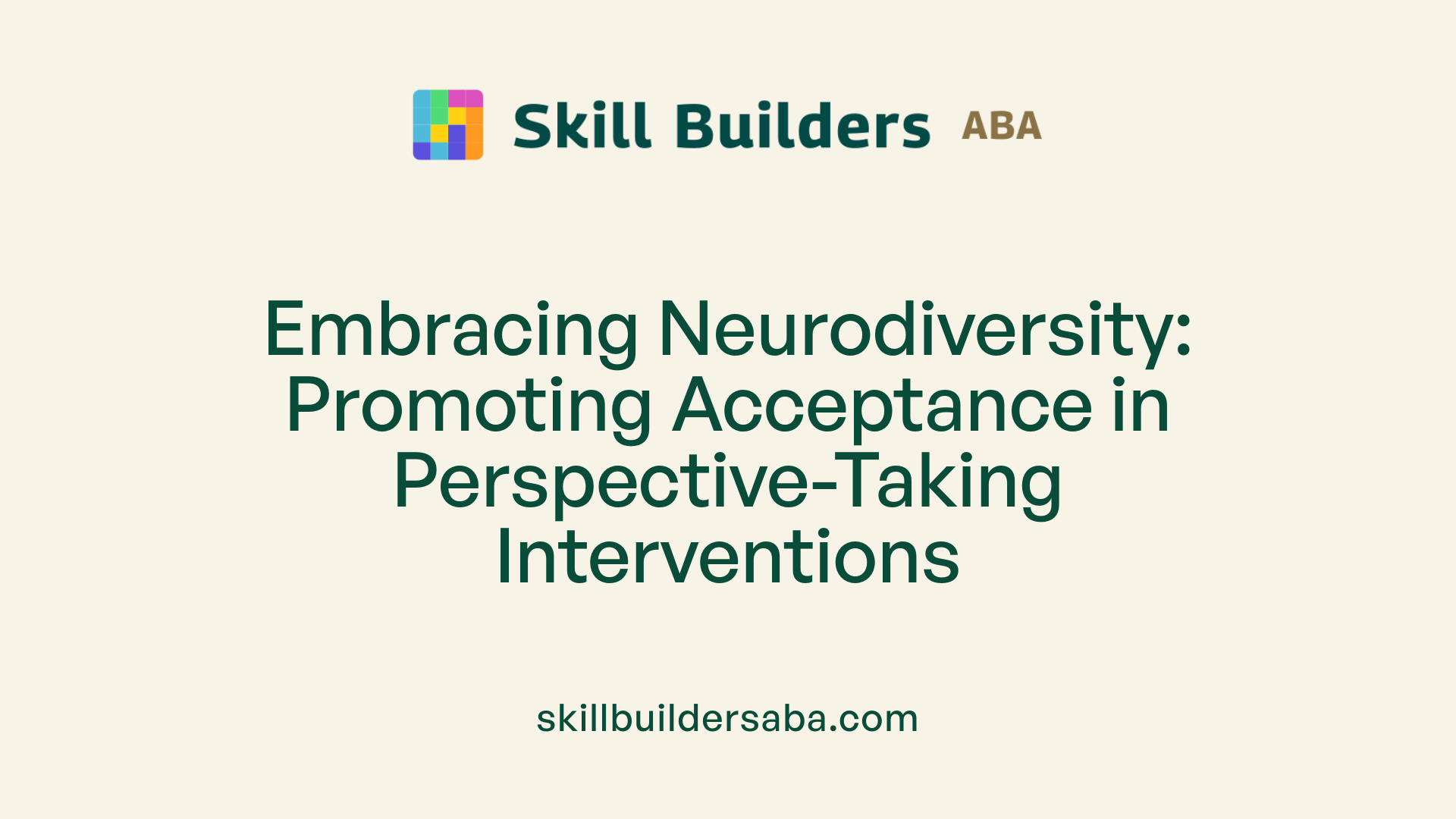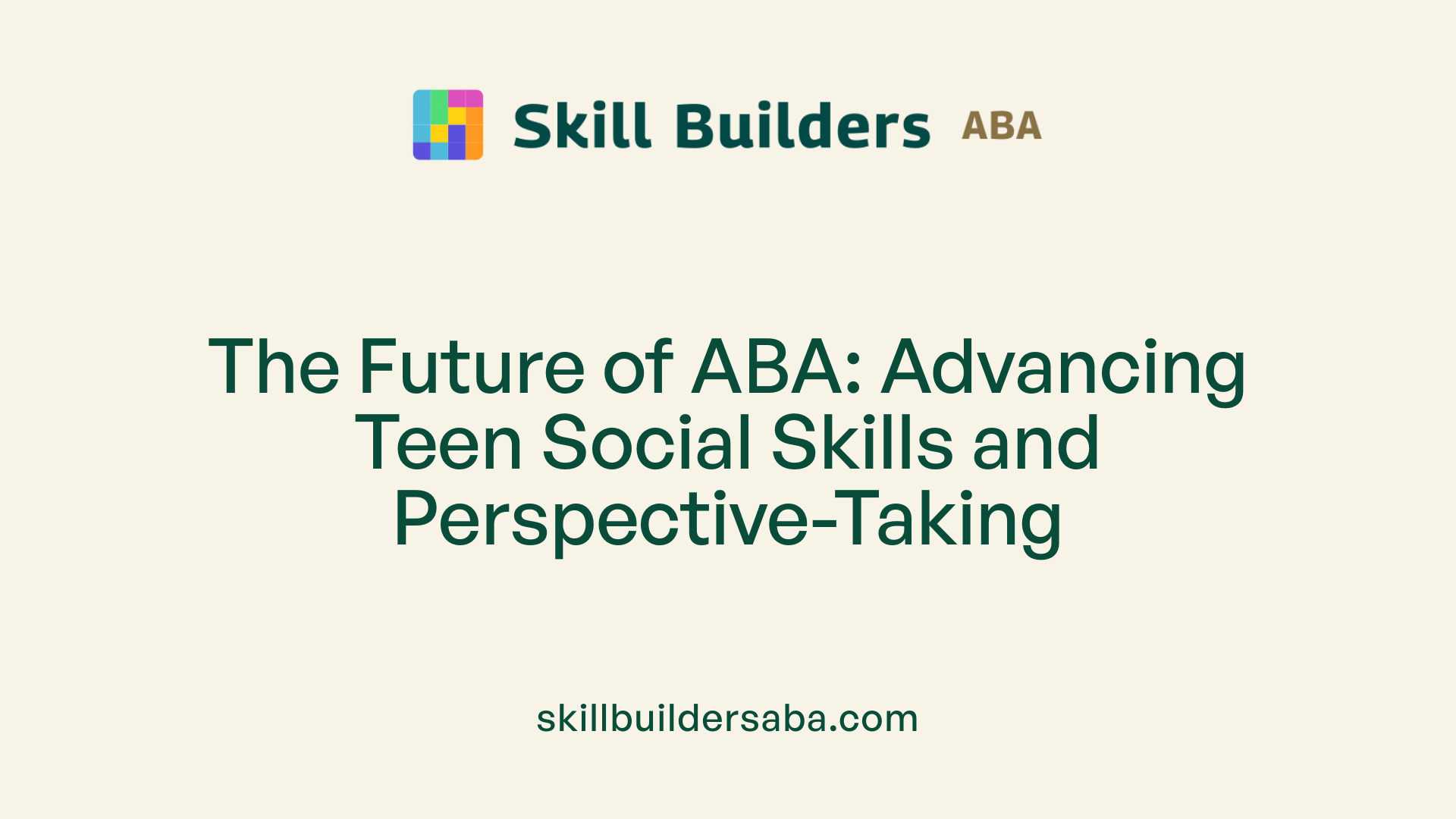How ABA supports perspective-taking in teens
Enhancing Social Skills in Adolescents with ABA Approaches

Understanding the Role of Perspective-Taking in Teen Development
Perspective-taking and theory of mind are vital skills that underpin effective social interactions and emotional understanding in adolescence. These abilities, which continue to develop through teenage years, involve the capacity to interpret others' thoughts, feelings, and intentions—fundamental components for navigating the complex social landscape of adolescence.
The Significance of Perspective-Taking and Theory of Mind in Adolescence
What is the importance of perspective-taking and theory of mind in adolescent development?
Perspective-taking and theory of mind are fundamental skills that develop significantly during adolescence. They empower teens to comprehend that others have thoughts, feelings, and viewpoints different from their own. This understanding is essential for effective social interactions, allowing adolescents to interpret social cues, predict others’ reactions, and respond empathetically.
Neurodevelopmentally, these abilities are linked to maturation in brain areas such as the prefrontal cortex and parietal lobes, which govern social cognition and executive functions. As adolescents grow, their capacity to relate to peers and navigate social complexities improves. They become better at recognizing emotions, understanding motives, and anticipating outcomes in various social settings.
Enhanced perspective-taking also contributes to prosocial behaviors like helping, cooperating, and showing empathy. These skills help adolescents build stronger, more meaningful relationships, foster self-awareness, and develop a nuanced self-concept. Overall, they are crucial for establishing a foundation for healthy social functioning throughout adulthood.
Why are perspective-taking and theory of mind particularly significant during teenage years?
During adolescence, individuals are exploring and solidifying their social identities and relationships. The development of perspective-taking and theory of mind enables teens to see situations from multiple viewpoints, manage conflicts more constructively, and develop genuine empathy.
This neurocognitive maturation supports their ability to navigate increasingly complex social environments, including peer groups, family, and community settings. It enhances emotional regulation and social competence, which are vital for academic success, mental health, and long-term relationship building.
Moreover, these skills aid in managing misunderstandings and reduce egocentric biases that are common in earlier childhood. As teenagers learn to understand and accept diverse perspectives, they become better equipped to participate in collaborative problem-solving and social problem resolution. This process ultimately fosters healthier communication and contributes to a more inclusive and empathetic society.
Activities in ABA to Foster Perspective-Taking in Children with Autism

What are effective activities used in ABA to improve perspective-taking in children with autism?
In Applied Behavior Analysis (ABA), several activities are utilized to develop perspective-taking skills in children with autism. Role-playing scenarios are particularly effective, as they give children opportunities to practice understanding others’ thoughts and feelings within a safe, simulated environment.
Social stories and narratives are also fundamental tools. These personalized stories illustrate social rules and highlight different viewpoints, making abstract concepts tangible for children.
Video modeling is another proven method. By watching videos that demonstrate appropriate social behaviors and perspectives, children can imitate these actions and learn how to navigate social situations.
To promote skill generalization, multiple exemplar training exposes children to a variety of social situations involving different perspectives. This helps them transfer what they learn across contexts.
Naturalistic teaching methods, including behavioral skills training, reinforce learning through prompts, reinforcement, and practicing skills in real-life settings. This combination of activities aims to foster meaningful improvements in social understanding and interpersonal interactions.
How do social narratives facilitate perspective-taking development?
Social narratives are personalized stories designed to explain social situations, focusing on the perspectives and feelings of others involved. These narratives help children interpret social cues, predict how others might respond, and appreciate different viewpoints. This structured approach makes understanding social nuances more accessible and supports the development of empathy and social reasoning skills.
Evidence-Based Strategies for Improving Social Cognition in Teens with Autism
To support teens with autism in developing social cognition skills, Applied Behavior Analysis (ABA) employs a range of evidence-based strategies. These methods focus on teaching essential social understanding, including perspective-taking, emotional recognition, and social problem-solving.
One effective approach involves the use of social stories, role-play, and video modeling. Social stories are simple narratives that illustrate social situations and appropriate responses, helping teens understand social cues and expected behaviors in various contexts. Role-play gives learners the chance to practice social interactions in a controlled, supportive environment. Video modeling allows teens to observe and imitate competent social behaviors, reinforcing correct social responses.
Reinforcement plays a vital role in encouraging the acquisition and generalization of perspective-taking skills. Positive reinforcement, such as verbal praise, tokens, or rewards, increases the likelihood that teens will engage in behaviors like recognizing others' emotions or predicting social outcomes. Consistent reinforcement during targeted activities helps these skills become habitual, fostering independence and confidence in social settings.
In addition to these strategies, ABA programs often incorporate visual supports like schedules and social scripts to clarify social expectations. Self-management techniques and opportunities for peer interactions are also integrated to promote real-world application. Engaging family members and caregivers in therapy ensures consistency across environments, reinforcing skills learned during formal sessions.
Advances in technology, including virtual reality and computer-assisted training, are expanding the scope of ABA interventions. These tools provide immersive, engaging experiences that mimic real-life social scenarios, enabling teens to safely practice and refine their social cognition skills.
| Strategy | Description | Benefits |
|---|---|---|
| Social Stories | Narratives describing social situations with expected responses | Clarifies social expectations |
| Role-Play | Acting out social scenarios in a safe setting | Builds practical social skills |
| Video Modeling | Watching videos demonstrating appropriate behaviors | Reinforces correct responses |
| Reinforcement Techniques | Providing rewards for targeted behaviors | Motivates and sustains learning |
| Technological Tools | Virtual reality and computer-based training | Engages and prepares for real-world social situations |
These strategies reflect a comprehensive, adaptive approach to fostering social cognition in teens with autism, emphasizing understanding and acceptance while promoting practical skills that support social integration.
How ABA Supports Perspective-Taking Skills in Teens with Autism

How does ABA support perspective-taking skills in teens with autism?
Applied Behavior Analysis (ABA) enhances perspective-taking in teens with autism through targeted, evidence-based strategies designed to improve understanding of others' thoughts, feelings, and motivations. Techniques such as direct teaching, social stories, video modeling, and naturalistic teaching create practical opportunities for teens to learn how to see situations from others' viewpoints.
Social stories and video modeling serve as visual tools that clearly illustrate social cues and interactions, helping teens recognize and interpret emotional responses and social behaviors. Naturalistic teaching embeds learning into everyday social settings, making the skills relevant and applicable.
ABA often incorporates principles from Social Thinking, which emphasizes understanding social cues and the reasons behind others’ actions, rather than insisting on conformity to neurotypical norms. This approach aims to foster empathy and genuine social understanding, supporting teens in developing skills that improve their social interactions and relationships. Overall, ABA's focus on respect and individual strengths encourages meaningful growth in perspective-taking, aligning with a neurodiversity-affirming perspective.
Are there ethical considerations in using ABA to promote perspective-taking?
Yes, ethical practices are crucial when applying ABA for social skill development. Interventions should respect each individual's unique social presentation and avoid pressuring neurotypical standards or masking behaviors that are authentic to the individual. The goal is to support understanding and acceptance, not to force conformity.
ABA strategies should empower teens to communicate and socialize according to their own comfort levels while fostering genuine insight into social dynamics. This means emphasizing self-determination and acceptance, ensuring that interventions enhance authenticity rather than suppress individual differences.
Additional Resources and Approaches
Organizations like Social Thinking provide comprehensive programs, curricula, and activities aimed at developing social cognition, including perspective-taking skills. These resources incorporate visual supports, social problem-solving activities, and metacognitive tools tailored to different ages, including teens.
The integration of relational frame theory (RFT) also informs strategies for teaching perspective-taking and executive functions such as attention, memory, and planning, which are vital for social understanding.
| Approach | Focus Area | Example Strategies | Intended Outcomes |
|---|---|---|---|
| Social Stories | Understanding social cues and expectations | Descriptive stories about social situations | Improved recognition of social cues, better social responses |
| Video Modeling | Visual learning of social interactions | Watching peers demonstrate social behaviors | Enhanced imitation, understanding, and empathy |
| Naturalistic Teaching | Embedding learning into real-life contexts | Using everyday routines to teach social skills | Generalization of skills to natural settings |
| Social Thinking Methods | Recognizing social-emotional chains and problem-solving | Activities like 'Should I? or Shouldn't I?' | Better social decision-making, perspective-taking, and empathy |
By employing these strategies responsibly, ABA can effectively support teens in developing perspective-taking skills, fostering more meaningful social interactions, and promoting acceptance and self-awareness.
Research Evidence Supporting ABA’s Effectiveness in Supporting Perspective-Taking

Are there specific research findings or resources that explain how ABA supports perspective-taking in adolescents?
Research provides strong support for ABA’s role in enhancing perspective-taking skills, particularly for autistic adolescents. A comprehensive systematic review of twenty studies reveals that ABA strategies—such as behavioral skill training, video modeling, role-playing, and derived relational training—are effective in teaching Theory of Mind (ToM) concepts, including emotion recognition and understanding others’ beliefs.
These interventions have demonstrated measurable improvements in social understanding and communication. For many learners, targeted ABA programs lead to better recognition of social cues, empathy development, and improved peer interactions. Importantly, existing guidelines from autism organizations stress that interventions should be tailored to individual needs, considering factors like language ability and severity of symptoms. Personalized approaches ensure that the skills learned are meaningful and generalize across settings, fostering more natural social integration.
How significant are the gains achieved through ABA-based perspective-taking interventions?
The progress seen through ABA interventions can be quite substantial. Many adolescents with autism show marked improvements in understanding others’ emotions, motives, and social outcomes. These gains translate into more effective social exchanges—fewer misunderstandings, enhanced peer connections, and greater confidence in social settings.
Research indicates that these enhancements not only improve immediate social interactions but also support longer-term social independence. As a result, ABA-based perspective-taking programs serve as a foundational element for fostering social competence, contributing to greater overall well-being and integration in community and school environments.
| Aspect | Description | Supporting Evidence |
|---|---|---|
| Intervention Types | Video modeling, role-playing, derived relational training | Studies show these methods effectively teach ToM skills |
| Outcomes | Improved emotion recognition, mental state understanding, social interactions | Quantitative improvements documented post-intervention |
| Influencing Factors | Language skills, symptom severity, individual motivation | Tailored approaches lead to better success |
| Resources | Autism organizations, professional guidelines | Emphasize ethics and naturalistic skill application |
This body of research affirms that ABA is a potent tool for developing perspective-taking, which is central to social competence and emotional understanding in adolescents with autism.
Promoting Acceptance and Neurodiversity in Perspective-Taking Interventions

How does ABA support perspective-taking skills in teens with autism?
Applied Behavior Analysis (ABA) uses specific, evidence-based methods to help teens with autism develop better understanding of others' thoughts, feelings, and motives. Techniques such as direct teaching, social stories, video modeling, and naturalistic teaching create real-life situations where teens can practice imagining and understanding different perspectives.
These strategies often incorporate elements from Social Thinking, focusing on how to interpret social cues and behaviors. Importantly, ABA aims to build these skills without forcing teens to hide their unique traits or conform to neurotypical behaviors. Instead, it emphasizes fostering empathy and social cognition in a respectful way.
Through these approaches, teens learn to navigate social situations more effectively, making connections that feel authentic to them. The goal is to cultivate functional perspective-taking skills that support positive social interactions and relationships, all while respecting the individual differences that make each person unique.
Why is it important for interventions to promote acceptance and accommodate diversity?
Promoting acceptance within perspective-taking strategies ensures recognition and respect for the diverse ways autistic individuals express social behaviors. Instead of trying to make autistic social presentation align with neurotypical standards, these interventions prioritize understanding, compassion, and genuine social inclusion.
This approach aligns with the principles of neurodiversity, which views neurological differences as natural variations rather than deficits. It encourages an environment where different social styles are valued equally, fostering a sense of acceptance rather than conformity.
Supporting diversity in social skills training not only benefits individuals by boosting their self-esteem and authenticity but also enriches social interactions by emphasizing genuine understanding over superficial masking. Ultimately, it helps create communities where all members feel respected and valued for their true selves.
Conclusion: The Future of ABA in Developing Teen Social Skills
 The development of social skills, especially perspective-taking, remains a vital area within Applied Behavior Analysis (ABA). As research accumulates, it increasingly supports that ABA strategies are effective in teaching these complex skills to adolescents, including those on the autism spectrum. Studies consistently show that evidence-based interventions like video modeling, behavioral skill training, and role-playing significantly improve understanding of others' mental states, emotions, and social cues.
The development of social skills, especially perspective-taking, remains a vital area within Applied Behavior Analysis (ABA). As research accumulates, it increasingly supports that ABA strategies are effective in teaching these complex skills to adolescents, including those on the autism spectrum. Studies consistently show that evidence-based interventions like video modeling, behavioral skill training, and role-playing significantly improve understanding of others' mental states, emotions, and social cues.
Resources from reputable autism organizations underscore the importance of respectful, individualized approaches that promote naturalistic application of skills across settings. This ensures that learning is meaningful and generalizes beyond therapy sessions. Emphasizing understanding and acceptance, rather than masking or forcing behaviors to fit neurotypical norms, aligns with ethical best practices.
Looking ahead, research points to expanding behavioral frameworks such as Relational Frame Theory (RFT) to better identify and target perspective-taking and executive functions. Practical guidelines now incorporate social-emotional chains, metacognitive strategies, and social cognition programs tailored for teens. These advancements aim to foster social independence and interpersonal understanding, supporting teens in navigating complex social landscapes with confidence.
Additional efforts are directed toward integrating social thinking models and visual supports to enhance engagement and comprehension. The goal is to grow interventions that are not only effective but also respectful of each individual's unique social presentation and needs. As we look to the future, a focus on evidence-based, ethical practices promises to bring more meaningful and inclusive social development options for adolescents within ABA frameworks.
Fostering Respectful, Evidence-Based Support for Teen Social Development
The integration of evidence-based ABA strategies emphasizes the importance of fostering social cognition and perspective-taking in a manner that respects individual differences and promotes genuine understanding. As research continues to evolve, the emphasis remains on interventions that are respectful, personalized, and rooted in the principles of neurodiversity, ensuring that adolescents with autism can develop meaningful social skills that support their growth and inclusion in society.
References
- Theory of Mind and Perspective Taking - How to ABA
- Why Perspective-Taking and Neurodiversity Acceptance? (Part 2 of ...
- Perspective-Taking in Childhood: Definition and Resources - Cadey
- Watch Video - Association for Behavior Analysis International
- Social Perspective Taking - Social Thinking
- Theory of Mind and Perspective Taking - How to ABA
- Why Perspective-Taking and Neurodiversity Acceptance? (Part 2 of ...
.svg)














